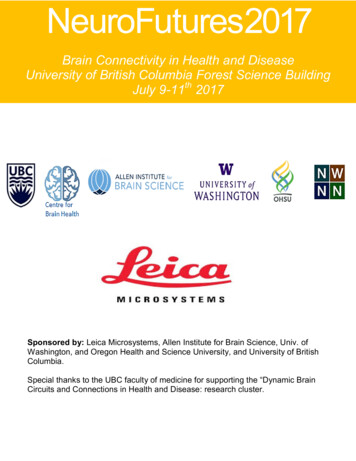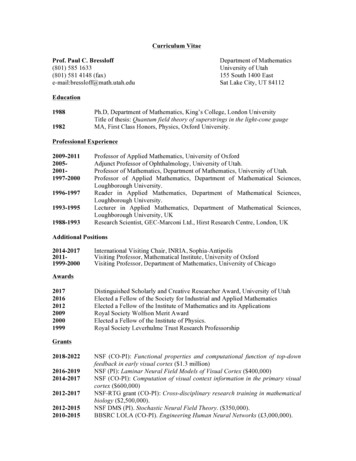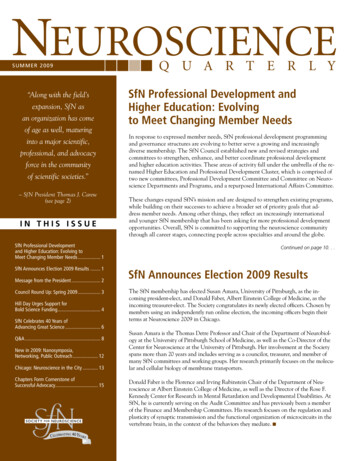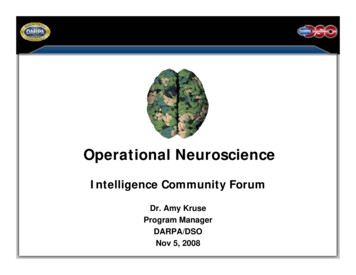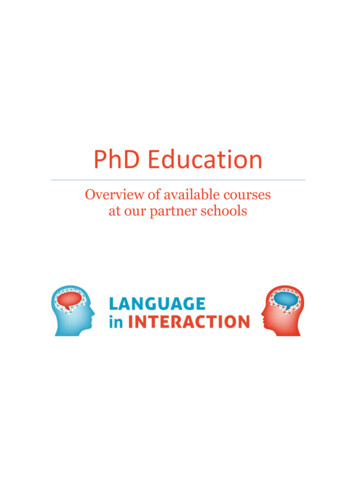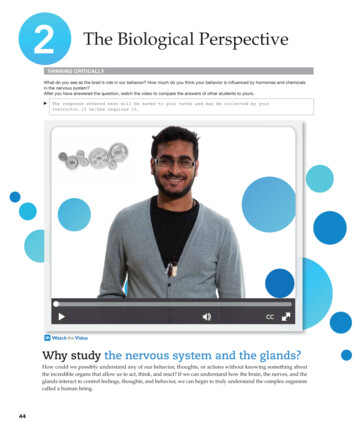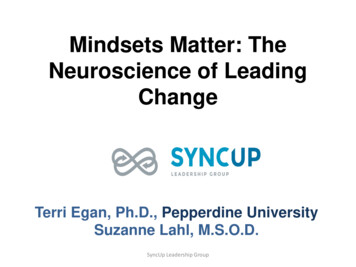
Transcription
The Milton H. Erickson Institute of the California Central CoastTHE NEW NEUROSCIENCE OFPSYCHOTHERAPY, THERAPEUTIC HYPNOSIS& REHABILITATION:A CREATIVE DIALOGUE WITH OUR GENESErnest Lawrence Rossi, Ph.D. & Kathryn Lane Rossi, Ph.D.1
Copyright 2008byErnest Lawrence Rossi, Ph.D. & Kathryn Lane Rossi, Ph.D.All rights reserved. No part of this book may be reproduced in any manner whatever, in wholeor in part (except for brief quotations and critical articles or reviews), without writtenpermission from the authors.Published by:Ernest Lawrence Rossi, Ph.D. and Kathryn Lane Rossi, Ph.D.125 Howard AvenueLos Osos CA 93402USAWWW.ErnestRossi.comEmail: Ernest@ErnestRossi.comEmail: Kathryn@ErnestRossi.comVersion 2.0, September 20082
Table of ContentsCHAPTER 1An Introduction to Milton H. Erickson, M.D. (1901-1980) . . . . . . . . . 5CHAPTER 2Historical Sources of Our New Neuroscience ofPsychotherapy, Therapeutic Hypnosis, and Rehabilitation . . . . . . . . . 8CHAPTER 3A New Neuroscience Model of the Four Stage Creative Processin the Humanities, Science and Psychotherapy . . . . . . . . . . . . . . . . 10CHAPTER 4Gene Expression, Brain Plasticity and Time in Psychotherapy . . . . . 18CHAPTER 5Life Turning Points: An Evolutionary Perspective on Self Creation,Dreaming and the Constructive Mind . . . . . . . . . . . . . . . . . . . . . . . . 24CHAPTER 6Mirror Neurons, Empathy, and ConflictArt, Truth and Beauty via Gene Expression and Brain Plasticity . . . . 28CHAPTER 7A Musical InterludeThe Sonata Form of the Four Stage Creative Process . . . . . . . . . . . . 35CHAPTER 8Four-Stage Creative Psychotherapy: Constructing Future Mind . . . 40CHAPTER 9Therapeutic Process #1The Four Stage Creative Process with Hand Mirroring . . . . . . . . . . . 47CHAPTER 10Therapeutic Process #2The Psychotherapeutic Facilitation of Clarity and Strength . . . . . . . 50CHAPTER 11Therapeutic Process #3Facilitating Consciousness & Creativity Integrating the Opposites. . 523
CHAPTER 12Therapeutic Process #4The Merry Symptom Chase for Mind-Body Healing . . . . . . . . . . . . . 55CHAPTER 13EpigeneticsThe Psychosocial Genomics of Gene Expression and Brain Plasticity. 58CHAPTER 14Workshop Evaluation & Research Form . . . . . . . . . . . . . . . . . . . . . . . 62References . . . . . . . . . . . . . . . . . . . . . . . . . . . . . . . . . . . . . . . . . . . . . . . . . . . . 63Table of Figures & TablesFigure 1: Cartoon of the Classic 4-Stage Creative Process . . . . . . . . . . . . . .10Figure 2: A Profile of the Human Brain during “Offline” Periods of Sleep. .12Figure 3: The Mind-Body Human Sensory-Motor Homunculus . . . . . . . . . .13Figure 4: Four Levels of the Psychobiological Domain of Psychotherapy . .14Figure 5: Neuron Illustration of Time Parameters of the Ultradian BRAC. .16Figure 6: Time Parameters of the Division of the Cells. . . . . . . . . . . . . . . . .19Figure 7: A Profile (90-120 minutes) of the 4-Stage Creative Process . . . . .20Table 1: Comparison of Ultradian Healing and Stress Responses . . . . . . . .21Figure 8: Domain of Hypnotherapeutic Work: High and Low Phases. . . . . .22Figure 9: Adaptive Dynamics during Life Transitions. . . . . . . . . . . . . . . . . . .24Figure 10: Mirror Neurons in Adaptive Dynamics . . . . . . . . . . . . . . . . . . . . .31Figure 11: The 4-Stage Outline of the Sonata Musical Form. . . . . . . . . . . . .35Figure 12: Therapeutic Process #1: Hand Mirroring. . . . . . . . . . . . . . . . . . . .48Figure 13: Therapeutic Process #2: Buddha Beneficence – Fear Not . . . . . .50Figure 14: Therapeutic Process #3: Integrating the Opposites . . . . . . . . . . .53Figure 15: Therapeutic Process #4: Transforming Symptoms into Signals. .55Figure 16: Social Group Influence of Gene Expression/Brain Plasticity. . . .58Table 2: Mind Modulation of Gene Expression in Human Leukocytes. . . . 604
CHAPTER 1An Introduction toMilton H. Erickson, M.D. (1901-1980)Milton H. Erickson, was described as “one of the most influential psychotherapists of all time” ina recent survey by The Psychotherapy Networker (March 2006). In psychotherapy Milton H.Erickson is ranked among the Top Ten along with Sigmund Freud, Carl Jung and others. Here istheir brief portrait of Erickson written about him a generation after his passing.“Despite everything that's been written about Milton Erickson and the diligent effortsof so many to understand just what he did in therapy and why it worked so remarkablywell, an air of mystery surrounds his work even now. Shortly after Erickson's death, his20-year student Jay Haley said, “Not a day passes that I don't use something that Ilearned from Erickson in my work. Yet his basic ideas I only partially grasp.” The imageof Erickson that's emerged in the field is that of a therapeutic wizard possessed of anoverwhelming personal power.“He wasn't the kind of person you'd just sit down and chat with,” recalls Jeffrey Zeig.“He was consistently working, consistently being Milton Erickson, which entailedhaving the most profound experience he could with whomever he was sitting with. Inthat sense, he was constantly hypnotic, constantly therapeutic, constantly teaching.”Perhaps this was because Erickson’s physical state necessitated the complete focus ofall his faculties. Dyslexic, tone deaf, color blind, prone to vertigo and disorientation,stricken with polio at 17 and again at 51, he spent the last 13 years of his life (theperiod in which many of his well-known students first met him) painfully confined to awheelchair. As he tried to model the flexibility and subtle verbal methods he'd spent alifetime developing, he did so with partially paralyzed lips and a dislocated tongue.Yet, as Haley said, “the man worked 10 hours a day, six or seven days a week doingtherapy. . . . Every weekend, he was either seeing patients or on the road teaching.”Zeig adds: “The thing that was so impressive about Erickson was the time and energyhe was willing to put out. Once he took somebody as a patient, he'd, literally, doanything he possibly could to help that person. When you were a client of Erickson, youjust felt he was totally focused on you.”Erickson spent a half-century developing an enormously subtle therapy of multileveledpattern recognition that was almost totally at odds with the mainstream therapies ofhis day. “Maladies,” Erickson said, “whether psychogenic or organic, follow definite5
patterns of some sort, particularly in the field of psychogenic disorders. A disruption ofthis pattern can be a most therapeutic measure, and it often matters little how smallthe disruption is, if introduced early enough.”He discovered that most of the “rules” of life prescribing human limitations werearbitrary beliefs, not facts. His study and mastery of hypnosis taught him that alteredmental states and trance were very much a part of everyday functioning. “Thisunderstanding,” wrote Ernest Rossi, “formed the underlying principles of his laterstudies of psychopathology as well as his development of the naturalistic andutilization approaches to therapeutic hypnosis.”Such insights were fundamental to Erickson's approach, but he sought no definitetheory to pass on as a legacy. “Erickson has no set method,” Haley noted. “If oneprocedure doesn't work, he tries others until one does. That's what he emphasized tohis students, advising a stance of heightened receptivity uncontaminated by formulaicpreconceptions.” Erickson put it this way: “I don't attempt to structure mypsychotherapy except in a vague, general way. And in that vague general way, thepatient structures it in accordance with his own needs The first consideration indealing with patients is to realize that each of them is an individual So in dealing withpeople, you try not to fit them into your concept of what they should be You shouldtry to discover what their concept of themselves happens to be It isn't the amount oftime. It isn't the theory of therapy. It's how you reach the personality by saying theright thing at the right time.”Further words of wisdom from Erickson: “Trust your unconscious. It's a very delightfulway of living, a very delightful way of accomplishing things.” And: “Don't try to usesomebody else's technique Just discover your own.”We believe these words, “Don't try to use somebody else's technique Just discover your own”are very important for therapists who wish to learn about themselves as well as Erickson.Therapists usually learn through trial and error the ways in which their unique personality canbe most effective in helping others. This requires courage, persistence, and honesty by eachpsychotherapist. It can be a lonely task learning how to do this.Who can possibly know better that you, yourself, when you are at your best and most effectivein facilitating others? It requires careful and continuous self reflection about what one is doing.No two people are exactly alike. No two therapeutic sessions can be exactly the same. Eachtherapeutic session is a unique creation, a unique piece of self development in the genesis ofnew consciousness and self identity in the patient and therapist. We expect that our empathy,understanding, and therapeutic efficacy will grow with each human encounter day by day.This essay for licensed professionals presents a new neuroscience perspective onpsychotherapy, therapeutic hypnosis, and rehabilitation as highly personal and creative6
dialogues with our genes. While this presentation is implied by much of the research we willquote, a great deal of further research will be needed to establish its scientific validity andtherapeutic efficacy. We outline a number of “experiential processes” as guiding heuristics fortherapeutic work. They are not, however, validated methods behavior change at this time.Rather, our approaches should be regarded as personal forms of self development in thehumanistic arts, autobiography, and meditation. They may be useful in the creation of newconsciousness, self knowledge, and self care that are of value to individuals who practice them,but they are not medical or psychological prescriptions for everyone. We begin with a briefoverview of some of our creative approaches in the history of the arts, medicine, andpsychotherapy as well as evolving neuroscience.Creative Implications Learning from others is only a beginning.Each therapist must develop their own special talents.Daily creative effort is required to optimize therapeutic skills.Each therapeutic session is a unique creation.7
CHAPTER 2Historical Sources of the NewNeuroscience of Psychotherapy,Therapeutic Hypnosis, andRehabilitationThe earliest sources of psychotherapy and therapeutic hypnosis began almost 300 years agowith Anton Mesmer’s defense of his medical thesis Dissertatio Physico-Medica de PlanetarumInfluxu on May 27, 1766. This was the time of the Swiss philosopher, Jean-Jacques Rousseau(1712-1778), when there were philosophical clashes between the mechanistic and naturalisticviews of human nature. Rousseau believed humans experienced developmental stages and thatthe “exercise” of mental abilities facilitated the growth of the brain. Charles Bonnet (17201793), an experimental naturalist familiar with Rousseau’s views, proposed to the Italianscientist Michele Vincenzo Malacarne (1744-1816) that neurons could respond to exercise justas muscles do. Malacarne (1793, 1819) then carried out experiments with littermates of birdsand dogs. He observed that those exposed to enriched environments and intensive training hadlarger brains! This was the forerunner of modern neuroscience research documenting hownovelty, exercise, training, and the voluntary focusing of attention can facilitate the growth andre-organization of neural networks of the brain. This is the foundation of our currentconceptions of how gene expression and brain plasticity in psychotherapy, therapeutic hypnosis,and rehabilitation can facilitate human development and healing (Rosenzweig, 1996,Rosenszweig, et al., 1962, Renner & Rosenzweig, 1987).The Physiology of Fascination in Therapeutic Hypnosis,Psychotherapy, and Modern NeuroscienceMedical pioneers such as Anton Mesmer (1734-1815) and James Braid, M.D. (1795-1860), whooriginally explored therapeutic hypnosis as a method of healing, had little understanding of howit actually worked. For example, James Braid’s defines hypnotism in his 1855 book, ThePhysiology of Fascination as follows:With the view of simplifying the study of reciprocal actions and reactions of mind andmatter upon each other. the (hypnotic) condition arose from influences existing withinthe patient's own body, viz., the influence of concentrated attention, or dominantideas, in modifying physical action, and these dynamic changes re-acting on the mindof the subject. I adopted the term “hypnotism" or nervous sleep for this process And8
finally as a generic term, comprising the whole of these phenomena which result fromthe reciprocal actions of mind and matter upon each other, I think no term moreappropriate than ‘psychophysiology’ (Braid, 1855).It is now believed that Braid actually invented the term “psychophysiology” to describe howmind and matter interact with each other to facilitate mind-body healing via therapeutichypnosis (Tinterow, 1972). Even today, 150 years later, exactly how psychophysiology operatesin mind-body therapy is not well understood. There are no generally recognized departments oftherapeutic hypnosis or mind-body therapy in our universities and medical schools that conductsystematic research on these therapies. Within the past generation, however, the newdiscipline of neuroscience has emerged with the advent of new technologies for the scientificinvestigation of the natural relationships between mind and body that Erickson (1958/2008,1959/2008) called his “naturalistic” and “utilization” techniques of hypnosis. Functionalmagnetic resonance imaging (fMRI), DNA microarrays, and bioinformatic DNA databases, forexample, have made a great deal of research available, which we will briefly review to updateour understanding of therapeutic hypnosis, psychotherapy, and rehabilitation.We will carefully summarize the implications of current neuroscience in a series of picturesillustrating the pathways of mind-body communication that we utilize in our therapeutic work.We will then illustrate some innovative approaches that are easy to learn and practice inprofessional workshops for licensed therapists. We have taught Erickson’s “naturalistic” and“utilization” approaches in professional workshops throughout the world for more than 40years. We present a few of them in carefully structured outlines for licensed professionals inthis essay (Rossi, 2002a, 2004a). We illustrate how they are capable of infinite variation by moreexperienced therapists.Throughout these practical exercises we will note where more research is now needed to meetthe criteria of evidence based medicine (EBT). Indeed, we invite you to cooperate in an opensource research program with us on an international level (Rossi, Rossi, Yount, Cozzolino &Iannotti 2006). The Ernest R. and Josephine R. Hilgard Award for Best Theoretical Paper in 2001,from The Society for Clinical and Experimental Hypnosis, reviews the scientific background of thecreative approaches we outline (Rossi, 2000). More detailed expositions may be found intextbooks (Rossi, 2002a, 2002b, 2004a, 2007), videotapes, and CDs available from the Milton H.Erickson Foundation Press (Erickson, Rossi, Erickson-Klein & Rossi, 2008) as well as pioneeringprofessional publications in creative hypnosis (Bloom, 1990).Creative Implications Novelty, exercise, training, and focusing attention can facilitate brain growth.The hypnotic condition arises from influences existing within the patient.The implications of neuroscience are a new research base for psychotherapy.Erickson’s “naturalistic” and “utilization” approaches are for licensed professionals.9
CHAPTER 3A New Neuroscience Model of theFour Stage Creative Process in theHumanities, Science & PsychotherapyA cartoon of the classical four stage creative process is presented in figure one, illustrating astudent engaged in proving a mathematical theorem (Tomlin, 2005). The first two panelsrepresent Stage One of the creative process where “the wheels start turning” in the mind andthe student begins making diagrams and writing equations trying to solve the problem.Figure 1: The four-stage creative process. Stage one is getting an idea and starting to work on a problem.Stage two is the sometime difficult experience of struggle and conflict trying to solve the problem. Stagethree is the creative moment of getting a flash of insight. Stage four is one of happy verification of theproblem solution. (With permission, Tomlin, 2005)As is typical of many problem solving efforts in everyday life, the student soon finds himself indifficulties. He feels “stuck” in Stage Two of the creative process, when his emotional conflictand despair is evident in the middle panel humorously showing smoke arising from hisoverheated brain. Stage Three of the creative process is illustrated in the next panel as a flash oflight surrounds his head. He is so surprised by his new creative insight that he drops his pencil!Stage Four of the creative process is evident as smiles with happiness with his success andexclaims, “Magic!” The popular lore of healing with psychotherapy and therapeutic hypnosishas frequently been described as magic. But how does this magic work? Here we will outline anew neuroscience model of how this so-called “magic” may operate in normal everyday life, ourdreams, and psychotherapy as a creative dialogue with our genes.10
The Mind-Brain-Gene DialogueCreative Replay as the Essence of PsychotherapyFigure two illustrates a profile of the human brain with a cutout showing details of thehippocampus, which is the part of the brain that first records a memory of what we experienceas new and surprising. The hippocampus, however, is only a temporary resting place forrecording new memory, learning, and behavior. Later, during so-called “offline” periods ofsleep, dreaming and rest when the conscious mind is not actively engaged in coping with outerrealities, the hippocampus and the brain engage in a dialogue to update, replay, and consolidatethe new life experience in an adaptive manner.Lisman & Morris (2001) describe this updating dialogue as follows:“ newly acquired sensory information is funneled through the cortex to thehippocampus. Surprisingly, only the hippocampus actually learns at this time — it issaid to be online. Later, when the hippocampus is offline (probably during sleep), itreplays stored information, transmitting it to the cortex. The cortex is considered to bea slow learner, capable of lasting memory storage only as a result of this repeatedreplaying of information by the hippocampus. In some views, the hippocampus is onlya temporary memory store — once memory traces become stabilized in the cortex,memories can be accessed even if the hippocampus is removed. There is now directevidence that some form of hippocampal replay occurs These results support the ideathat the hippocampus is the fast online learner that “teaches” the slower cortexoffline.” (p. 248-249, italics added)This “updating dialogue,” which proceeds on an unconscious or “implicit level” is the essence ofour new neuroscience model of creativity in psychotherapy. It only seems like a kind of “hiddenmagic” to our conscious mind when we awaken from sleep, dreaming, and deep states of innerfocusing in everyday life. We are surprised to realize we are aware of something new. As weshall soon see, the creative replaying of adaptive, novel, and significant life experiences betweenthe cortex and the hippocampus is the basic life process that we seek to facilitate inpsychotherapy, therapeutic hypnosis and rehabilitation. This entirely natural “psychobiologicaldialogue” is the essential process that we attempt to facilitate in our new neuroscience model ofcreative therapeutic suggestion. From this new neuroscience perspective therapeutic suggestionsmay be more aptly described as “implicit processing heuristics,” which facilitate this naturaldialogue between the hippocampus and the cortex as illustrated in Figure two.11
Figure 2: A profile of the human brain during “offline” periods of sleep, dreaming and rest when thehippocampus and the cortex engage in a dialogue (blue arrows) to replay, update, and consolidate thenew memory and learning (Updated from Rossi, 2002a). This entirely natural psychobiological “dialogue”is the essential process that we attempt to emulate, facilitate, and utilize in our new neuroscience modelof implicit processing heuristics.The Human Brain and the “Rapport Zones”Of Psychotherapy and Therapeutic HypnosisFigure three illustrates some of the “rapport zones” on the cerebral cortex, which we believe arethe actual areas of the human brain that are engaged in the creative dialogues of psychotherapyand therapeutic hypnosis (Rossi & Rossi, 2006).12
Figure 3: The Mind-Body Human Sensory-Motor Homunculus. The oversize hands and lip-tongue-facialanatomy reflect the unusually large areas of the brain that evolution has selected to map these twoimportant areas of grasping and communication (Adapted from Penfield & Rasmussen, 1950). A. Thesensory homunculus is postulated as being activated in a set of “rapport zones” via the ideo-sensoryprocesses of therapeutic hypnosis. B. The motor homunculus is postulated as activated in a set “rapportzones” during the ideomotor processes of therapeutic hypnosis.Mind-Body CommunicationThe Basic Rest-Activity Cycle (BRAC)The time frames on the right side of figure four illustrate another profoundly important aspectof mind-body therapy. Mind-body communication, via our nervous system, takes place almostinstantly in milliseconds. The flow of mind-body communication via molecular messengers suchas hormones in the blood stream throughout the body, however, requires about a minute.When these signals are received by cells, many of them are communicated to the nucleus of thecell where they “turn on” gene transcription (gene expression).13
Figure 4: Four levels of the psychobiological domain of psychotherapy, therapeutic hypnosis, andrehabilitation. (1) Information from the outside world encoded in the neurons of the cerebral cortex of thebrain is transformed within the limbic-hypothalamus-pituitary system into the messenger molecules thattravel through the blood stream to signal receptors on cells of the brain and body. (2) Receptors on the14
surface of cells transmit the signal via 2nd messengers to the nucleus of the cell where immediate-earlygenes signal other target genes to transcribe their code into messenger RNAs. (3) The messenger RNAsserve as blueprints for the synthesis of proteins that will function as (a) the ultimate healing structures ofthe body, (b) enzymes to facilitate energy dynamics and (c) receptors and messenger molecules for theinformational dynamics of the cell. (4) Messenger molecules function as a type of “molecular memory”that can evoke state-dependent memory, learning and behavior in the neural networks of the brain(illustrated as the rectangular array of letters A to L on the top). (From Rossi, 2002a, 2004a, 2007)Genes express a DNA code to make proteins that are “molecular machines” that can carry outthe physical healing in mind-body therapy. As illustrated in figure four, an entire cycle of mindbody communication and healing—as well as the ordinary activities and performances of dailylife takes about 90-120 minutes—this is sometimes called an “Ultradian Cycle” (in contrast tothe “Circadian” or daily 24 hour cycle). In chronobiology (the biology of time) it is also called“The Basic Rest-Activity Cycle” (BRAC) (Lloyd & Rossi, 1992, 2008). This means that afundamental unit of mind-body communication in therapy can be initiated and take place withinthe typical time parameters of a single session of psychotherapy or therapeutic hypnosis. It isnoteworthy that Milton H. Erickson (Erickson, Rossi, Erickson-Klein, Rossi, 2008), generallyregarded as one of the most innovative psychotherapists of our time, typically conducted hissessions of therapeutic hypnosis for 90-120 minutes.The operation of the BRAC within a single neuron of the brain is illustrated in figure five. New,surprising, and unexpected life experiences can turn on “activity-dependent genes” important formaking the proteins, which generate the growth and transformations of the synapticconnections between neurons that is described as “brain plasticity” (Rossi, 2000, 2004a, 2007).15
Figure 5: The time parameters of the ultradian basic-rest activity cycle illustrating how neurons in thebrain, when stimulated by novel and salient signals from the environment, actually turn on activitydependent gene expression, new protein synthesis, and brain plasticity. (Adapted from Kandel, 2001,2006; Rossi, 2002a, 2004a, 2007).The illustrations of this chapter provide a brief overview of the new neuroscience model of thecreative process from mind to gene, which we will now explore in greater detail.16
Creative Implications We utilize a new neuroscience model of the creative process from mind to gene.Facilitating our natural mind-brain-gene dialogue is the essence of psychotherapy.An entire cycle of mind-body communication and healing takes about 90-120 minutesPsychotherapeutic experiences can turn on genes and brain plasticity in a single session.17
CHAPTER 4Gene Expression, Brain Plasticity andTime in PsychotherapyGene expression and brain plasticity are the physical basis of the natural transformations ofmind, consciousness, and behavior. Figure 6 illustrates how new synaptic connections areformed between neurons every hour or two of the basic rest-activity cycle. Our neurosciencemodel of psychotherapy and therapeutic hypnosis via a creative dialogue with our genes utilizesthis entirely natural time frames of life that have evolved over millions of years of evolution.Direct evidence for gene expression and brain plasticity facilitated by psychotherapy is beingrapidly documented at this time (Kandel, 2001; Lichtenberg, et al., 2000, 2004; Rossi, 2002b,2004b, 2005-2006, 2007, 2008). Evidence for the involvement of gene expression and brainplasticity in psychotherapy was originally emphasized by Eric Kandel (Kandel, 2001, 2006), whorecently won a Nobel Prize for his lifetime of research in this area. Kandel (1998) states thisperspective as follows:“Insofar as psychotherapy or counseling is effective and produces long-term changes inbehavior, it presumably does so through learning, by producing changes in geneexpression that alter the strength of synaptic connections and structural changes thatalter the anatomical pattern of interconnections between nerve cells of the brain. Asthe resolution of brain imaging increases, it should eventually permit quantitativeevaluation of the outcome of psychotherapy . Stated simply, the regulation of geneexpression by social factors makes all bodily functions, including all functions of thebrain, susceptible to social influences. These social influences will be biologicallyincorporated in the altered expressions of specific genes in specific nerve cells ofspecific regions of the brain. These socially influenced alterations are transmittedculturally. They are not incorporated in the sperm and egg and therefore are nottransmitted genetically.” (p. 460, italics added)Research with the combined technologies of DNA microarrays, functional magnetic resonance(fMRI), and bioinformatic data bases such as the Allen Brain Atlas of geneexpression http://www.brainatlas.org/aba/ are now needed to meet the requirements ofevidence based medicine for the involvement of gene expression and brain plasticity inpsychotherapy.18
Figure 6: The ultradian (time) dynamics of activity-dependent memory, learning, and behavior change asproposed by Lüscher et al., (2000). Within the first 10 minutes there are measurable changes in geneexpression and the activation (phosphorylation) and growth of receptors that are involved in synapticcommunication via neurotransmitters. Within 30 minutes the size of the synaptic spine increases andreceptors move to the postsynaptic membrane; this leads to an increase in the size of the postsynapse.Within an hour, some postsynapses divide in two. This leads, in turn, to further growth in presynapticmultiplication and remodeling that eventually create new neural networks encoding memory, learning,and behavior change that is of essence for psychotherapy and many activity-dependent processes of geneexpression, protein synthesis, and synaptogenesis during creative human experiences in the arts andsciences as well as everyday life. Research suggests that four weeks to four months are required tostabilize new neural networks encoding new memory and learning (Van Praag et al., 2002). This simplefact suggests the natural time parameters for the neuroscience of brief psychotherapy and rehabilitation.Darwin, Evolution, Adaptation and Time for HealingIn an unusually prescient statement of his natural selection theory of adaptation, Charles Darwin(1859) intuited what we now describe as the natural time parameters psychotherapy as follows:It may be said that natural selection is daily and hourly scrutinizing, throughout theworld, every variation, even the slightest; rejecting that which is bad, preserving andadding up all that is good; silently and insensibly working, whenever and whereveropportunity offers, at the improvement of each organic being in relation to its organicand inorganic conditions of life. We see nothing of these slow changes in progress,until the hand of time has marked the long lapses of ages, and then so imperfect is ourview into long past geological ages, that we only see that the forms of life are nowdif
The Physiology of Fascination in Therapeutic Hypnosis, Psychotherapy, and Modern Neuroscience Medical pioneers such as Anton Mesmer (1734-1815) and James Braid, M.D. (1795-1860), who originally explored therapeutic hypnosis as a method of hea


